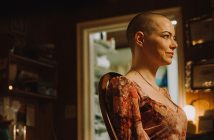 It used to be said that there were only two things you could count on in this life: death and taxes. We should probably go ahead and add remakes to the list. They’ve become a fact of life – something we cannot escape, no matter how hard we try and how much we complain. They just simply are. Great. Now that we’ve accepted that remakes are going to be a big part of moviegoing culture for the foreseeable future, we can get down to the business of figuring out which ones are good and which ones are not. Surprisingly, “The Last House on the Left,” a remake of Wes Craven’s 1972 debut, is actually one of the good ones. Not great, mind you, but good – especially when one considers the source material was flawed to begin with. The new movie, on which Craven has a producer credit, manages to actually outclass the original on numerous levels, although there are still a couple areas of the old movie (which was produced on a shoestring budget) that are more interesting than what’s presented here.
It used to be said that there were only two things you could count on in this life: death and taxes. We should probably go ahead and add remakes to the list. They’ve become a fact of life – something we cannot escape, no matter how hard we try and how much we complain. They just simply are. Great. Now that we’ve accepted that remakes are going to be a big part of moviegoing culture for the foreseeable future, we can get down to the business of figuring out which ones are good and which ones are not. Surprisingly, “The Last House on the Left,” a remake of Wes Craven’s 1972 debut, is actually one of the good ones. Not great, mind you, but good – especially when one considers the source material was flawed to begin with. The new movie, on which Craven has a producer credit, manages to actually outclass the original on numerous levels, although there are still a couple areas of the old movie (which was produced on a shoestring budget) that are more interesting than what’s presented here.
The new movie more or less tells the same story as was presented in ‘72. A violent lunatic named Krug (Garret Dillahunt) escapes police custody and is on the run. Across town, teenage Mari (Sara Paxton) hooks up with her old friend, Paige (Martha MacIsaac), and they in turn hook up with shy, introverted Justin (Spencer Treat Clark) who promises them he’s got some really good weed back in his hotel room. Once there, Justin’s father, Krug, enters the picture, along with his sleazy girlfriend, Sadie (Riki Lindhome), and his psychotic brother, Francis (Aaron Paul). Against their will, the two girls are taken to a remote area of the woods where they suffer all manner of indignities, which culminates in a thoroughly ugly rape sequence that goes on seemingly forever. It goes on so long that I actually had to fast forward the final part of it because I couldn’t take it anymore. With the girls left for dead, Krug and company trek through the woods in the rain, and find themselves at “the last house on the left,” which just so happens to be the summer home of Mari’s parents, John (Tony Goldwyn) and Emma (Monica Potter). It doesn’t take the couple long to figure out what’s happened to their daughter, and who’s responsible, and from there the picture shifts into a rollercoaster of torture porn that’s actually one hell of ride if you can find enjoyment in such scenarios.

In the Craven version, the parents are only out for revenge against Krug and his lackeys. They demanded payback for what was done to their daughter. In this new version, the revenge angle somewhat remains, but a pivotal element is introduced into the final hour that turns the events into more of a survival game, and in the process, the story becomes less of a cartoon than the second half of Craven’s version. (Is it worth mentioning that the ‘72 version isn’t necessarily “the original”? That honor goes to Ingmar Bergman’s “The Virgin Spring” from 1960.) Further, the Justin character is given a sympathetic side, which is a nice touch, as nobody really wants to believe that a teenage kid could possibly approve of his father’s despicable behavior toward two fellow teenagers. A major element that’s been removed is the subplot of the bumbling police officers. It’s anyone’s guess how that would have played out had it been included, but it isn’t, and I certainly didn’t find myself missing it.
Another major difference is the acting, which in the Craven version veered anywhere from acceptable to poor. Not so here. Tony Goldwyn and Monica Potter aren’t necessarily go-to names when one is looking for strong performances, but I’ll be damned if they don’t both deliver the goods and pretty much own the last hour of the film. Garret Dillahunt, on the other hand, is a fine, underrated actor, so it’s no surprise when he makes good on this interpretation of Krug, who’s just such a deliciously evil piece of trash that the final moments of the film, which see him getting his, are pretty cathartic for the viewer. There were moments when the entire thing was even reminiscent, just ever so slightly, of Scorsese’s “Cape Fear,” a movie which happens to be another reason to not instinctively dismiss remakes.
So where does the film fall short of Craven’s version? As is to be expected, this is a slick Hollywood production, whereas Craven’s low-budget documentary feel made for a somewhat more harrowing experience – or at least it did in the first hour leading up to and including the rape. Speaking of the rape, while it’s just as strong a sequence in the remake, the emotional aftermath isn’t nearly as out of the ordinary. There was something going on between David Hess and Sandra Cassel – something that, even as actors, couldn’t possibly have been rehearsed or staged. There was a palpable disgust in the looks they were giving one another, and I’m not even sure it was all acting. Afterwards, Mari stumbled into the lake, and simply gave up on life. Much like the weird songs which were written and sung by Hess (and are absent from this version), the filmmakers of the new version must be given kudos for not even trying to duplicate the parts of the original that made it so damn original – so it’s unfair for me to say the film falls short in really any area in comparison to the ’72 version.
There were some smart people behind this movie, but it’s a shame they sold their audience a little short. They no doubt improved upon Craven’s version, but had they more faith in the moviegoing public, they probably could have made an even smarter and more operatic piece – something more along the lines of the aforementioned “Cape Fear.” Perhaps the person that tackles the remake will go back to the Bergman film for some inspiration.
3.5 / 5 Stars
Starring: Tony Goldwyn, Monica Potter, Sara Paxton, Garret Dillahunt, Spencer Treat Clark, Aaron Paul, Martha MacIsaac, Riki Lindhome
Director: Dennis Iliadis
Reviewed by Ross Ruediger
Single-Disc Blu-Ray Review:
Aside from the option to choose either the theatrical or the unrated version (the latter runs 4 minutes longer), there are a handful of deleted scenes, of which only one is particularly noteworthy. There’s also a letdown of a featurette called “A Look Inside,” which runs less than three minutes and amounts to little more than a trailer with a few comments by Craven and director Dennis Iliadis spliced into it.

